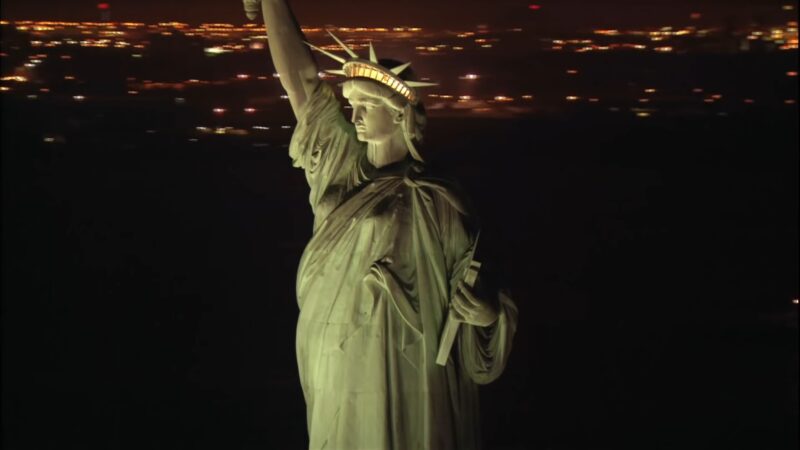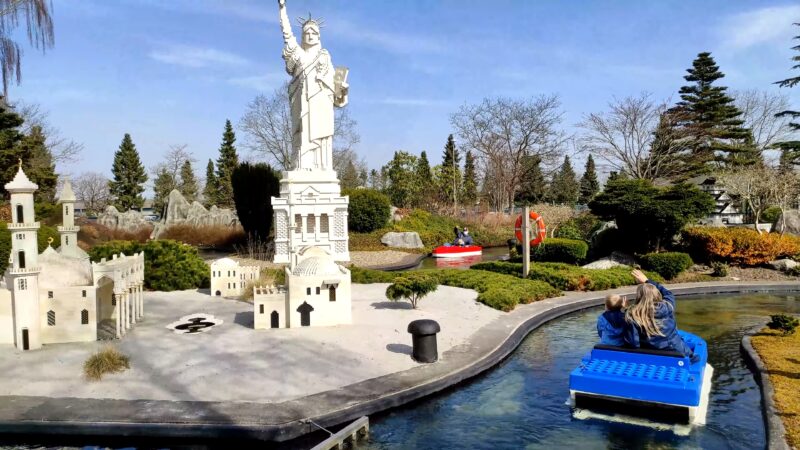The Liberty Enlightening the World stands tall as a symbol of freedom, democracy, and the enduring relationship between France and the United States. This colossal neoclassical sculpture, located on Liberty Island in New York Harbor, was a generous gift from the people of France to the United States.
Designed by the French sculptor Frédéric Auguste Bartholdi, with its metal framework built by Gustave Eiffel, the statue was dedicated on October 28, 1886. But did you know there are multiple Statues of Liberty around the world?
We’ll explore the history of the original statue and its replicas. And for those curious minds, we’ve included tables listing the statues and their details.
The Original Statue of Liberty

The Statue of Liberty is a representation of Libertas, the Roman Goddess of Liberty. She proudly holds a torch above her head with her right hand, while her left hand carries a tabula ansata inscribed with JULY IV MDCCLXXVI, marking the date of the U.S. Declaration of Independence. Symbolizing the abolition of slavery, a broken chain and shackle lie at her feet.
The idea for this magnificent statue was conceived in 1865 by the French historian and abolitionist Édouard de Laboulaye. He proposed a monument to commemorate the centennial of U.S. independence and the liberation of the nation’s slaves. The statue’s construction was a monumental task. It was built in France, shipped to the U.S. in crates, and then assembled on Liberty Island, formerly known as Bedloe’s Island.
Feature |
Description |
| Location | Liberty Island, New York City |
| Height of copper statue | 151 feet 1 inch (46 meters) |
| Total height from ground to torch | 305 feet 1 inch (93 meters) |
| Dedicated | October 28, 1886 |
| Sculptor | Frédéric Auguste Bartholdi |
| Visitors (2009) | 3.2 million |
Replicas and Miniatures
The Statue of Liberty’s significance has led to the creation of numerous replicas and miniatures worldwide. These replicas, ranging from small tabletop models to large-scale statues, can be found in various cities and serve different purposes. Some are tributes to the original statue, while others serve as symbols of freedom and democracy in their own right.
One of the most notable replicas is the smaller version of the statue presented by the American community in Paris to the city in 1889. This statue faces west, towards the original Statue of Liberty in New York. Another famous replica is the one in Las Vegas, which has become an iconic part of the city’s skyline.
The purpose of these replicas varies. Some are erected to celebrate ties between countries, while others serve as tourist attractions or symbols of freedom and democracy.
The Statue of Liberty in Paris

Ah, Paris! The city of love has its own Statue of Liberty, and it’s a sight to behold. Located on the Île aux Cygnes, a narrow artificial island in the Seine, the Parisian Statue of Liberty stands as a symbol of the deep-rooted friendship between France and the United States.
Historically, this replica has a unique connection to the original statue in New York. It was given to the city of Paris by the American community in 1889, just a few years after the New York statue was erected. The Parisian statue faces west, in the direction of its larger sibling across the Atlantic, symbolizing the bond between the two nations.
While both statues were designed by Frédéric Auguste Bartholdi, there are some differences between them. The Parisian statue is smaller, standing at 11.5 meters (37 feet) tall, and holds a tablet inscribed with the date “IV JUILLET 1776” (July 4, 1776), the day the American Declaration of Independence was adopted. This date is complemented by “XIV JUILLET 1789,” the day the French Revolution began.
The Las Vegas Statue of Liberty

Las Vegas, the city of lights and entertainment, boasts its own replica of the Statue of Liberty. Located outside the New York-New York Hotel & Casino, this statue is a popular attraction for tourists and locals alike.
While it’s not as grand as the original, the Las Vegas Statue of Liberty stands at half the size of the New York statue. It’s an integral part of the hotel’s skyline, which also features other iconic New York landmarks like the Brooklyn Bridge and the Empire State Building.
What’s fascinating about the Las Vegas statue is its role in popular culture. It has been featured in numerous movies, TV shows, and commercials. Moreover, in a mix-up, the U.S. Postal Service mistakenly used an image of the Las Vegas replica instead of the original statue for a stamp design in 2010!
| Feature | New York Statue | Las Vegas Statue |
| Height | 93 meters (including pedestal) | Approximately 46 meters |
| Location | Liberty Island | New York-New York Hotel & Casino |
| Date of Completion | 1886 | 1997 |
The Las Vegas Statue of Liberty, with its glitzy backdrop, serves as a reminder of the universal appeal of Lady Liberty and how she has been adapted to fit different contexts and settings.
The Statue of Liberty in Other U.S. Locations
In many U.S. cities, smaller-scale replicas of the Statue of Liberty can be found. These statues, often erected by the Boy Scouts of America in the 1950s as part of their Strengthen the Arm of Liberty campaign, were meant to celebrate the Boy Scouts’ 40th anniversary. They aimed to highlight the scouts’ creed of freedom and readiness.
For instance, if you ever find yourself in Birmingham, Alabama, you’ll be greeted by a 36-foot tall replica at Liberty Park. Over in Duluth, Minnesota, a 20-foot tall bronze replica stands proudly on the Duluth Harbor South Breakwater outer light. And these are just a couple of examples. There are many more scattered across the country, each with its own unique story and significance.
United States Replicas |
| Liberty Warehouse, Manhattan, New York |
| Brooklyn Museum of Art, New York |
| Metropolitan Museum of Art, New York |
| Duluth, Minnesota |
| Warner Park, Madison, Wisconsin |
| 667 Madison Avenue, Manhattan, New York |
| New York-New York Hotel & Casino, Las Vegas, Nevada |
| McKennan Park, Sioux Falls, South Dakota |
| Vestavia Hills, Birmingham, Alabama |
| Liberty National Bank Building, Buffalo, New York |
| Dauphin Narrows of Susquehanna River, Pennsylvania |
| McRae, Georgia |
| San Marcos, California |
| Memphis, Tennessee |
| Cherokee Capitol Building, Tahlequah, Oklahoma |
| Fargo, North Dakota |
| Lake Chaubunagungamaug, Webster, Massachusetts |
| Milwaukie, Oregon |
| Alki Beach Park, West Seattle, Washington |
| Everett, Washington |
| Mackinac Island, Michigan |
| New Castle, Pennsylvania |
| Ellwood City, Pennsylvania |
| Neenah, Wisconsin |
| Forney, Texas |
| Burns, Oregon |
| Richmond National Battlefield, Richmond, Virginia |
| Lake Michigan campground, Wisconsin |
| Layton, Utah |
International Replicas

The Statue of Liberty’s influence isn’t just limited to the U.S. shores. Her iconic image has been replicated in various countries around the world. And each of these replicas has its own tale to tell.
European Replicas |
|---|
| Musée d’Orsay, Paris (France) |
| Île aux Cygnes, Paris (France) |
| Musée des Arts et Métiers, Paris (France) |
| Flame of Liberty, Paris (France) |
| Barentin (France) |
| Bordeaux (France) |
| Colmar (France) |
| Saint-Cyr-sur-Mer (France) |
| Minimundus, Klagenfurt (Austria) |
| Graz (Austria) |
| Legoland, Billund (Denmark) |
| Heidepark Soltau, Soltau (Germany) |
| Mulnamina More, County Donegal (Ireland) |
| Hotel Victory, Pristina (Kosovo) |
| Assen (Netherlands) |
| Visnes (Norway) |
| Cenicero (Spain) |
| Rossend Arús public library, Barcelona (Spain) |
| Cadaqués (Spain) |
| Lviv (Ukraine) |
| Leicester (United Kingdom) |
| Warrington (United Kingdom) |
For instance, in Visnes, Norway, there’s a replica that stands as a testament to the fact that the copper used in the original statue came from a mine in this very town. Over in Tokyo, Japan, a smaller replica graces the Odaiba seaside park, offering a unique blend of American and Japanese cultures.
Asian Replicas |
| Ishinomaki (Japan) |
| Osaka (Japan) |
| Tokyo (Japan) |
| Shenzhen (China) |
| Lahore (Pakistan) |
| Bangalore (India) |
But why do other countries choose to erect replicas of the Statue of Liberty? For many, it’s a symbol of the enduring friendship and shared values between their country and the U.S. For others, it’s a beacon of hope, freedom, and democracy.
Americas Replicas (excluding USA) |
| – Coquitlam, British Columbia (Canada) |
| – Repentigny, Quebec (Canada) |
| – Campeche, Palizada (México) |
| – Durango, Parque Guadiana (México) |
| – Buenos Aires, Barrancas de Belgrano Square (Argentina) |
| – Buenos Aires, Colegio Nacional Sarmiento (Argentina) |
| – Buenos Aires, “New York” Casino in San Luis (Argentina) |
| – Buenos Aires, Galería de Fabricantes, Munro (Argentina) |
| – Bangu, Rio de Janeiro (Brazil) |
| – Maceió, Alagoas (Brazil) |
| – Rio de Janeiro, New York City Center shopping mall (Brazil) |
| – Araçatuba, Havan department store (Brazil) |
The Impact of the Replicas
The numerous replicas of the Statue of Liberty scattered around the globe are a testament to her universal appeal and the values she represents. These replicas, regardless of their size or location, carry with them the spirit of freedom, hope, and democracy.
It’s fascinating to see how the Statue of Liberty has become a global symbol. From small towns in the U.S. to major cities in other countries, her image resonates with people from all walks of life. It’s not just about the statue itself but what she stands for. The replicas serve as a constant reminder of the universal desire for freedom and the belief that it’s attainable.
FAQ

How did the replicas of the Statue of Liberty come into existence?
The idea of replicating the Statue of Liberty began as early as the late 19th century. Many replicas were created for various reasons, from commemorating the original statue to symbolizing the shared values of freedom and democracy. Some replicas were also sold to finance the Statue of Liberty project in the 1880s.
Are there any significant differences between the original statue and its replicas?
While many replicas aim to closely resemble the original, there are differences in size, materials used, and sometimes design details. For instance, the replica in Tokyo Bay represents the relationship between France and Japan and is about 1/7th the size of the statue in New York Harbor.
What’s the story behind the Statue of Liberty replicas in Paris?
Paris is home to at least 12 replicas. The most notable is the statue on the manmade Île aux Cygnes (Swan Island) on the Seine, which is in close proximity to the Eiffel Tower. Alexandre-Gustave Eiffel, who designed the Eiffel Tower, also designed the statue’s interior.
How are the replicas spread across the world?

Replicas of the Statue of Liberty can be found on almost every continent. From the original Legoland in Billund, Denmark, which houses a replica made from 400,000 Lego bricks, to a 9-foot-high replica in Rio de Janeiro, Brazil, the influence and admiration for Lady Liberty are truly global.
Conclusion
From the majestic original on Liberty Island to the numerous replicas around the world, the Statue of Liberty stands as a powerful symbol of freedom, hope, and democracy.
Each replica, no matter its size or location, carries with it a piece of the original’s spirit and legacy. As we’ve journeyed through the various replicas and their stories, it’s evident that Lady Liberty’s influence is far-reaching.
She’s not just an American icon but a global one, reminding us all of the enduring values she represents. What a remarkable journey it’s been, exploring the many faces and stories of Lady Liberty!
